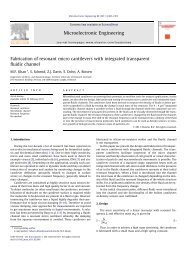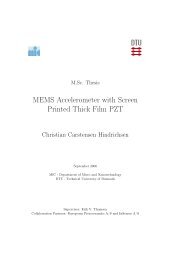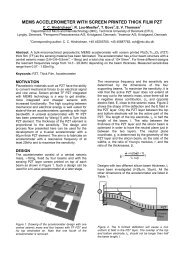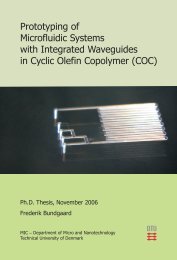Development of a Oxygen Sensor for Marine ... - DTU Nanotech
Development of a Oxygen Sensor for Marine ... - DTU Nanotech
Development of a Oxygen Sensor for Marine ... - DTU Nanotech
Create successful ePaper yourself
Turn your PDF publications into a flip-book with our unique Google optimized e-Paper software.
6.2. THE FLEX PRINT 53<br />
The reason behind letting the conducting glue dry slowly in step 3, rather<br />
than putting it in the oven right away, was that tests showed a lack <strong>of</strong> connection<br />
if the glue hadn’t dried properly first.<br />
Also it should be noted that while the solution with the conducting glue<br />
does work, it is not the most optimal solution, as the yield on working sensors<br />
with this solution is discouragingly low.<br />
6.2 The flex print<br />
There was also another problem with the wirebonds, or rather the flex print,<br />
even if the wire had been successfully attached to both the output electrodes<br />
and the flex print. After taking the packaged device out <strong>of</strong> the oven, the flex<br />
print appeared to bend upwards, despite the glue. This had the side effect<br />
<strong>of</strong> making the thread snap <strong>of</strong>f at one <strong>of</strong> the ends. Hence cutting <strong>of</strong>f the connection<br />
between the chip and the flex print. The reason <strong>for</strong> this appears to<br />
be that the flex print used, isn’t suitable <strong>for</strong> use with temperatures over 80 C.<br />
Figure 6.6: Picture from a chip, where conducting glue have been used to<br />
<strong>for</strong>m the connection between chip and flex print, as can be seen<br />
the flex print have bend and caused the connection to break.<br />
So in order to solve this, a way to keep the wire attached or to prevent<br />
the flex print from bending had to be found.










